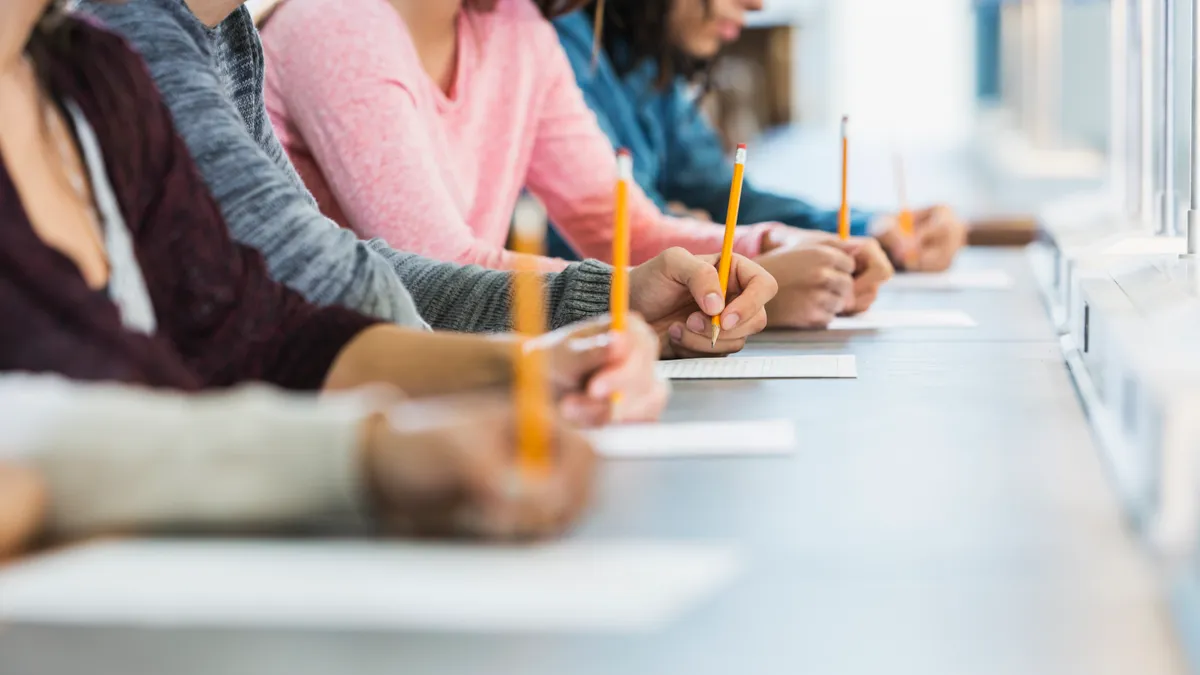Dive Brief:
- Pandemic academic recovery in both reading and math is lagging notably behind pre-COVID achievement trends for students in grades 4-8 during the 2022-23 school year, according to a new report by NWEA analyzing MAP Growth test scores of 6.7 million students across 20,000 public schools.
- Third-graders were the only group who saw improvements, and they were slight, according to NWEA, an educational research organization recently acquired by learning technology company HMH.
- Reading achievement declines by grade ranged from 1% to 19% for grades 4-8, and math declines by grade ranged from 6% to 15% when compared to pre-pandemic trends from the 2016-17 through 2018-19 school years, NWEA said. Meanwhile, 3rd-graders saw gains of 4% in reading and 2% in math compared to the same pre-pandemic period.
Dive Insight:
To catch up to pre-pandemic levels, NWEA estimates the average student will require 4.1 additional months of reading instruction and 4.5 more months of math.
When looking at the data across race and ethnicity, achievement gains declined from pre-pandemic levels for all students in 2022-23. However, “marginalized students remain the furthest from recovery,” the report said.
These findings were an unpleasant surprise to Karyn Lewis, the report’s co-author and director of the Center for School and Student Progress at NWEA. As of fall 2022, NWEA had seen ongoing — though modest — signs of improvement in student achievement, she said.
“It felt like we were on the right path,” Lewis said. “The team and I, we felt a lot of trepidation about what would happen in this current school year, hoping to see continued progress. And that is not what the data are showing.”
To catch up to pre-COVID achievement levels in reading, NWEA found Black and Hispanic elementary school students would need an additional 2.6 months, compared to 1.9 months for White students and 1.2 months for Asian students. Starker gaps emerge in reading recovery needs at the middle school level, with Hispanic students requiring 6.7 months to catch up, versus 4.9 months for Black and White students and 1.4 months for Asian students.
Similar patterns are seen in math, where Asian and White elementary students need 2.2 months of additional math instruction to catch up to pre-pandemic trends, while Hispanic students need 2.9 months, and Black students need 3.2 months.
In middle school, more instruction is needed across the board, but racial gaps still persist in math for these older students. For instance, Hispanic students need 6.4 months to return to pre-pandemic levels, Black students need 6.2 months, White students need 5.3 months, and Asian students need 4.3 months.
The NWEA report also shows a lack of success for recovery efforts aimed at students experiencing inequitable academic progress even before the pandemic. The fact that all students are sluggishly trailing pre-pandemic achievement levels suggests there was no additional catchup for any students, particularly those from historically marginalized backgrounds, Lewis said.
“There’s no additional recovery among the student groups who’ve been hardest hit,” Lewis said.
“When we talk about recovery across student groups, we need to be mindful about whether we’re aiming for a goal of recovering to the pre-pandemic status quo, which was already highly inequitable," Lewis said. "Or, if we can learn lessons in this moment to establish new best practices, that we can do better than just getting back to pre-COVID — because normal is not good enough.”
But Lewis said she wants to avoid assumptions that federal pandemic recovery investments like the Elementary and Secondary School Emergency Relief Funds were for nothing or were mismanaged. If anything, she said, the country would be in a “much more dire situation if we had not had that funding and the supports to schools to be able to implement the recovery initiatives that they have put in place.”
What’s really concerning to Lewis is that the ESSER spending deadline for fall 2024 is nearing, and with it the funding to support academic recovery. “We have to adopt a longer-term perspective to be able to comprehensively support kids in a sustainable way,” she said.
The NWEA data also adds a bit more nuance to the ongoing research previously released on the magnitude of K-12 academic setbacks from the pandemic, Lewis said. While NAEP showed the extent to which pandemic learning loss exists, the NWEA findings more specifically measure the latest progress being made — or not — in academic recovery from the pandemic.
In June, the latest data from the Nation's Report Card painted a dismal picture of the nation’s 13-year-olds not showing any signs of academic recovery in math and reading, on top of the already alarming results for 9-year-olds.













